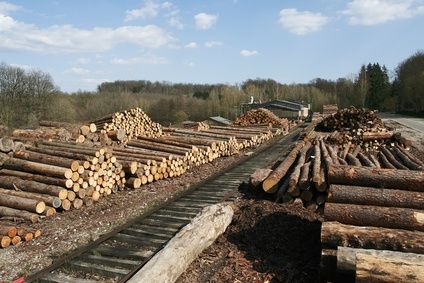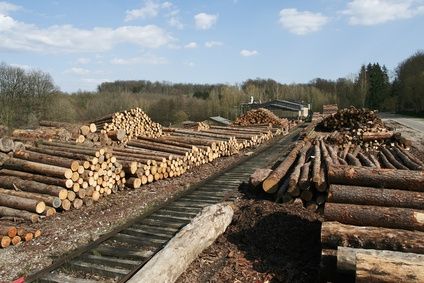当一个开发人员提升计算机系统负荷时,通常会考虑两种方式垂直扩展和水平扩展。选用哪种策略主要依赖于要解决的问题以及系统资源的限制。在这篇文章中我们将讲述这两种策略并讨论每种策越的优缺点。如果你已经有一个软件系统需要不断成长,那么你将有意或者无意中选择这两种策略中的一种。
垂直扩展
在垂直扩展模型中,想要增加系统负荷就意味着要在系统现有的部件上下工夫,即通过提高系统部件的能力来实现。例如,假设你现在负责一批木材采伐的操作。

在这个例子中,我们假设有3辆卡车,每辆车一次可以运25根木材,计算花费1小时的情况下可以运送到指定地点等待处理的木材数量。通过这些数字我们可以算出我们系统最大的负荷量:
3辆卡车 * 25根木材 * 1小时=75根木材/小时
如果我们选择垂直扩展模型,那么我们将怎么做来使我们每小时可以处理150根木材?我们需要至少做以下两件事中的一件:
使每辆卡车的运输量增加一倍(50棵树每小时),或者使每辆卡车的运输时间减半(每辆卡车30分钟)。
3辆卡车 * 50棵树 * 1小时 = 150棵树/每小时
或者
3辆卡车 * 25棵树 * 30分钟 = 150棵树/每小时
我们没有增加系统的成员数,但是我们通过增加系统成员的生产效率来获得期望的负荷量。
水平扩展
在水平扩展模型中,我们不是通过增加单个系统成员的负荷而是简单的通过增加更多的系统成员来实现。也就是说,在以上运送木材的例子中,通过增加卡车的数量来运送木材。因此,当我们需要将负荷从75棵树每小时增加到150棵树每小时,那么只需要增加3辆卡车。
6辆卡车 * 25棵树 * 1小时 = 150棵树/每小时
假如我们已经选择了垂直扩展方式,那么我们想要每小时处理150棵被砍伐的树时需要怎么做呢?我们需要做到以下两方面之一:要么使每辆卡车的运输量翻倍(50棵木材一次),要么使每辆开车的运输时间减半(30分钟)。
3辆卡车 * 50棵树 * 1小时 = 150棵树/每小时
或者
3辆卡车 * 50棵树 * 30分钟 = 150棵树/每小时
在这个例子中,系统每个成员的生产力依然没变,我们通过增加更多的卡车来提高系统的能力。
扩展你的web数据库
通过对水平扩展和垂直扩展的基本了解,下面让我们来关注web系统的扩展。一个网站通常有很多组件都需要去考虑它们的扩展性,但是我通常喜欢关注处在最边缘的一个:数据库。为什么数据库是最边缘的?因为数据库通常是共享资源,是几乎所有请求最终的连接点。
你的系统是什么类型的?
在扩展你的数据库时,你必须要问的一个重要问题是:“我所面对的系统是什么类型的?”你所面对的是一个读操作多还是写操作多的系统?读操作多的网站一般包括:在线商城,在商城里用户大部时间是在浏览(读操作),只有少数时间在付款(写操作)、或者博客,在博客上人们大部分时间是在浏览博文(读操作),只有少数时间是在评论或者发表博文(写操作)。相反的,关于写操作非常多的很好的例子包括:信用卡交易处理器,这个系统的主要负载时在处理记录交易(写操作),偶尔会查找交易(读操作)、或者Google分析,主要工作实在记录业务数据(写操作),偶尔会展示分析图(读操作)。
了解你所创建的网站是什么类型的,可以在网站成长过程中帮助你选择正确的技术。
读操作扩展
如果你的系统读操作非常多,那么通过关系型数据库如mysql或者PostgreSql来垂直扩展数据存储是一个不错的选择。结合你的关系型数据库通过使用memcached或者CDN来构建一个健壮的缓存系统,那么你的系统将非常容易扩展。在这种模式中,如果数据库超负荷运行,那么将更多的数据放入缓存中来缓解系统的读压力。当没有更多的数据往缓存中放时,可以更换更快的数据存储硬件或者买更多核的处理器来获取更多的运行通道。摩尔定律使通过这种方法来垂直扩展变得和购买更好的硬件一样简单。
写操作扩展
如果你的系统写操作非常多,那么你可能更希望考虑使用可水平扩展的数据存储方式,比如Riak,Cassandra或者HBase。和大多数关系型数据管理系统不同,这种数据存储随着增长增加更多的节点。由于你的系统大部分时间是在写入,所以缓存曾并不能像在读操作比较频繁的系统中起到那么大作用。很多写频繁的系统一开始使用垂直扩展的方式,但是很快发现并不能根本解决问题。为什么?因为硬盘数和处理器数在某一点达到平衡,在这个边界上再增加一个处理器或者一个硬盘都会是每秒钟的I/O操作数成指数性增长。相反,如果对写频繁的系统采取水平扩展策略,那么你将达到一个拐点,在这个拐点之后如果在增加一个节点都远比使用更多的硬盘来的实惠。
其他注意事项
另一件事需要记住的是每种扩展策略下预想不到的开销。采用垂直扩展的系统将开销凡在单独的组件上。当我们去提升系统负荷时,这些单独的组件需要在管理上花费更多。拿我们运送木材的例子来说,如果需要使每辆卡车的货运量翻倍,那么我们需要更宽、更长、或者更高的车厢。也许有的路因为桥的高度对车辆高度有要求,或者基于巷子宽度车宽不能太大,又或者由于机动车安全驾驶要求车厢不能太长。这里的限制就是对单个卡车做垂直扩展做的什么程度。同样的概念延伸到服务器垂直扩展:更多的处理器要求更多的空间,进而要求更多的服务器存储架。
相反的,采用水平扩展的系统将额外的开销放在系统中连接起来的共享组件上。当我们去提升系统负荷时,共享的开销和新增加的成员之间的协调性有关。在我们运送木材的例子中,当我们在路上增加更多卡车时,那么路就是共享资源也就成了约束条件。这条路上适合同时跑多少量卡车?我们是否有足够的安全缓冲区使得所有的车可以同时装运木材?如果再来看我们水平扩展的数据库系统,那么经常被忽略的开销就是服务器同时连接时的网络开销(译者注:网络为各个系统的共享资源)。当你为系统增加更多的节点时,共享资源的负荷也就越来越重,通常呈非线性改变。
综合说明
和计算机的大多数东西一样,好的解决办法通常并不像我这里列出来的这么简单。而我在这里尝试简化这种思想用来来说明这中概念而不是讲具体的解决办法。扩展是个困难的问题,这是个需要在实际处理的每个步骤中都要思考的问题。扩展策略没有魔法,也没有魔法般的软件帮你建立一个完整可靠的可扩展系统。就像扩展中的其他问题一样,一个大的解决方案通常是由很多个一起协调工作的小的解决办法组成的。这需对每一个中解决方案进行精心正确的设计和开发。
Understanding Horizontal and Vertical Scaling
When a developer needs to add more capaticy to a computer system, he usually considers two ways to do so: horizontal scaling or vertical scaling. Which strategy is selected depends on the problem being solved, and the limited resources in the system. In this post, we’ll go over both of these scaling strategies, and discuss the pros and cons of each. If you’re building a software system that needs to grow, you either select a scaling strategy explicitly, or a strategy is selected implicitly. Be intentional about knowing how your system is going to grow.
Vertical Scaling
In a vertical scaling model, the process of adding more capacity means taking existing actors in a system and increasing their individual power. For example, let’s say you’re in charge of overseeing a lumber harvesting operation.

In this example, let’s assume you have 3 trucks that can carry 25 felled trees per load, and it takes 1 hour to move each load down the road to where it needs to be further processed. Given these numbers, we see that the maximum capacity of our system is:
3 trucks * 25 trees * 1 hour/load = 75 trees processed per hour
Assuming we’ve chosen a vertical scaling capacity model, how would we respond if we wanted to be able to process 150 felled trees per hour? We’d need to do one of two things: either double the carrying capacity of each truck (50 trees per hour), or halve the time it takes for each truck to process each load (30 minutes).
3 trucks * 50 trees * 1 hour/load = 150 trees processed per hour
OR
3 trucks * 25 trees * 30 minutes/load = 150 trees processed per hour
We haven’t increased the number of actors in the system, but we have increased the productivity of each actor to achieve the desired jump in capacity.
Horizontal Scaling
In a horizontal scaling model, instead of increasing the capacity of each individual actor in the system, we simply add more actors to the system. In our lumber harvesting example, this means adding more trucks to move the lumber. So when we need to increase our capacity from 75 trees per hour to 150 trees per hour, we simply add 3 more trucks:
6 trucks * 25 trees * 1 hour/load = 150 trees processed per hour
The productivity of each actor in the system remains the same, but we’ve added more trucks to the system.
Scaling Your Web Database
With a basic understanding of horizontal and vertical scaling, let’s look at scaling a web system. There are numerous components in a website that need their scalability properties considered, I’d like to focus on one that usually ends up being the most critical: the database. Why is the database the most critical? Because your user’s data is usually what people care about the most. Because data is often a shared resource, it becomes the main contact point for nearly every web request.
What Kind of System Is Yours?
The most important question you have to ask when considering the scalability of your database is, “What kind of system am I working with?” Are you working with a read-heavyor a write-heavy system? Examples of a read-heavy website might include: An online shopping site, where most people spend the majority of their time browsing (reads) and only a small amount of their time purchasing (writes), or a blog, where the majority of the time people are consuming posts (reads), and only a small amount of the time are commenting or the author is posting (writes). On the flip side, good examples of a write-heavy system include: A credit card transaction processor, where the main workload is journaling transactions (writes), and occasionally looking up transactions (reads), or Google Analytics, where the majority of the workload is journaling traffic data (writes) and occasionally showing graphs of the analytics (reads).
Knowing what kind of system you’re building will help you select the right technologies when your website has to grow.
Scaling Reads
If your website is primarily a read-heavy system, vertical scaling your datastore with a relational database such as MySQL or PostgreSQL can be a good choice. Couple your RDBMS with a robust caching strategy that uses memcached or a CDN and you’ll have a system that can scale pretty cheaply. In this model, when the database runs out of capacity, putting more pieces of data in the cache helps offset the burden of reads. When there’s no more items left to cache, upgrading your database hardware with faster disks or more processors will usually buy you the necessary runway. Moore’s law makes vertical scaling with this method as simple as buying better hardware.
Scaling Writes
If your website is primarily a write-heavy system, you’re probably going to want to think about using a horizontally scalable datastore such as Riak, Cassandra or HBase. Unlike most RDBMSes, these datastores usually grow by adding more nodes. Because your system is going to be mostly writing, caching layers will not help you much like in a read-heavy system. Many write-heavy systems start out using a vertical scaling strategy, but soon run out of runway. Why? Because hard-drives and processor counts plateau at a certain point, and the marginal cost of adding one more core or a harddrive that does a few more I/O ops per second grows exponentially. If you instead choose a horizontally scalable strategy for your write-heavy system, you reach an inflection point where the marginal cost of adding one more node to the system becomes far cheaper than the cost of a harddrive that might eek out a few more disk seeks.
Other Considerations
Another thing to keep in mind is the often unforseen costs of each scaling strategy. In a vertical scaling setup, extra costs are placed on the isolated individual components of the system. As we add more capacity to the system, the individual components become more costly to manage. From our lumber harvesting example, if we make our trucks to carry twice the number of trees per load, our trucks beds are going to have to get either longer, wider, or taller. Perhaps there’s a height restriction for the roadway based on bridge height, or a width restriction based on lane width, or a length restriction based on safe driver maneuverability. There’s a limit to how much vertical scaling you can do with the individual components of the truck. The same concepts apply to vertical scaling servers: more processors require more case room which requires more individual server rackspace.
In contrast, a system that scales horizontally places extra costs on the connected sharedcomponents of the system. As we add more capacity to the system, the shared costs associated with coordinating the actors increases. In our lumber harvesting example, as we add more trucks to the road, the road is a shared resource that becomes constrained. Can that many trucks even fit on the road at the same time? Do we have enough safe loading zones that all the trucks can be receiving lumber simultaneously? If we look at our horizontally scalable database system, the often overlooked cost on the system becomes the network that connects the servers together. As you add more nodes to the system, this shared resource often becomes increasingly taxed, usually in a non-linear fashion.
Fitting It Together
Like most things in computers, good solutions are not usually so simple as what I’ve outlined here. I’ve attempted to simplify the ideas in order to speak to the concepts, rather than any specific tactics. Scaling is a hard problem, that needs pragmatic thought at every step of the process. There is no magic scaling tactic, or magic software that will help you build an entirely reliably scalable system. Like many other problems of scale, the larger solution is usually made of hundreds of tiny solutions all working together in unison. Getting each of them right takes careful design and at every step of development.






















 9308
9308

 被折叠的 条评论
为什么被折叠?
被折叠的 条评论
为什么被折叠?








